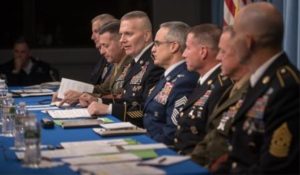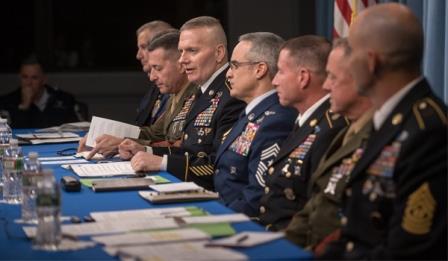The U.S. Armed Forces and Department of Defense depend on executive leadership to make sound and timely decisions during important military and government meetings. Due to the high level of responsibility and accountability promotion and assignment into these top executive leadership roles is not taken lightly. In fact, there are rigorous standards in place designed to critically vet each candidate in order to make sure that they have the proper background and experiences to lead during critical times.
While there are various leadership roles within the U.S. military and DoD, this article focuses on the nominations and assignments of General Officers, Flag Officers, and Command Senior Enlisted Leaders in the U.S. military and appointments to Senior Executive Service positions within the DoD.

General and Flag Officer Appointments
The term Flag Officer is normally a distinction reserved for naval officers operating within the U.S. Navy or Coast Guard while the term General Officer refers to non-naval officers responsible for commands within the U.S. Army, Marine Corps, or Air Force. Both types of officers, Flag or General, are senior officers in the Armed Forces and at a minimum hold a pay-grade of O-7 and above.
Selection and appointment for these senior officer positions is similar. Primary eligibility criteria include Time in Service and Time in Grade among other qualifying factors. Time in Service is the cumulative amount of time a service member has rendered in service to the U.S. Armed Forces. On the other hand, Time in Grade is the amount of time a service member has spent in their current pay-grade such as O-6. However, officers seeking promotion to pay-grade O-7 and above face much higher standards, rigorous qualifications, and stringent vetting processes in order to be selected for promotion to a Flag or General officer.
For example, an officer who seeks promotion to a General or Flag officer has their official military records reviewed by a specific promotion board that is primarily concerned with only promotions within the General officer / Flag officer ranks. Since this promotion board is singularly focused on only a specific type of promotion, the board is able to review each candidate more critically ensuring that selected officers possess the required leadership skills and abilities to carry out their duties.
In addition to the demanding screening process that is conducted by the promotion board, once the board identifies a potential candidate they make a recommendation to the President of the United States. Then the President has the option to either accept or decline the recommendation. If the President accepts the recommendation they nominate the candidate for promotion. However, once the President communicates this nomination, the U.S. Senate must confirm it in order for the promotion to be approved.
The path to achieving promotion into the General Officer / Flag Officer ranks is challenging and dependent on a thorough and rigorous selection board, nomination from the President of the United States, and confirmation by the U.S. Senate.
Command Senior Enlisted Leader Appointments
Command Senior Enlisted Leaders serve as the vital link between commanding officers and the enlisted workforce. Senior Enlisted Leaders normally report directly to the commanding officer and are responsible for reporting the status of the enlisted ranks and ensuring good order and discipline among enlisted service men and women. Senior Enlisted Leaders fill the top leadership roles reserved for the enlisted ranks, and promotion to senior level roles is challenging.
Promotion into Senior Enlisted Leadership roles is rigorous as these positions are expected to up hold the high standards of the U.S. military and serve as exemplary examples to all enlisted personnel. For example, it is expected that senior leaders have superior leadership skills and have been exposed to a broad range of management experiences. In addition, Senior Enlisted Leaders must be excellent communicators as one of their core responsibilities is to ensure efficient and effective communication up and down the chain of command. Also, serving in highly visible positions demands that Senior Enlisted Leaders have a sharp military appearance and character. They must demonstrate discipline in terms of their military bearing and preferably exceed minimum health and physical standards.
In order to be selected for promotion, a special selection board comprised of senior officers and other Senior Enlisted Leaders convenes each year to scrutinize each candidate’s military record ensuring that candidates possess the leadership skills needed to serve in senior roles.
Senior Executive Service (SES) Appointments
While the U.S. military requires outstanding leadership skills from it’s top ranking officers and senior enlisted personnel, the Federal service representing the civilian workforce also has stringent requirements for their top executives. For example, the Senior Executive Service (SES) is comprised of key positions that fall just below the top Presidential appointees. In addition, the SES serves as the critical link between these positions and rest of the Federal workforce. In order to gain a position within the SES, candidates must pass a demanding selection process. However, these positions don’t require an appointment by the President nor Senate confirmation.
The selection process for SES appointments is directed by specific qualification review boards facilitated by the Office of Personnel Management. These selection boards are designed to vet each executive candidate ensuring that they have outstanding leadership skills and experience, possess a core set of common values, and have a deep understanding of the U.S. government.
The U.S. government and Armed Forces takes into careful consideration the nomination and appointment of its senior leaders. All promotions and nominations are earned by completing demanding screening processes and demonstrating outstanding leadership skills. Upper executive leaders have risen to the top and represent the highest standard of achievement in their respective branches and fields. While career paths leading to top executive positions can be challenging and competitive, both the U.S. military and U.S. government ensure that only the most qualified candidates earn appointment into senior level roles.
